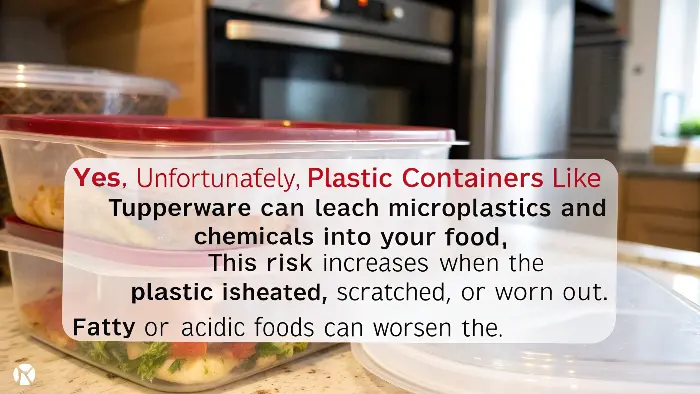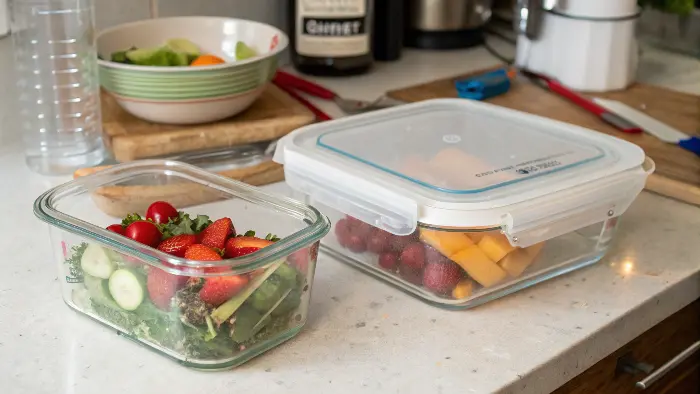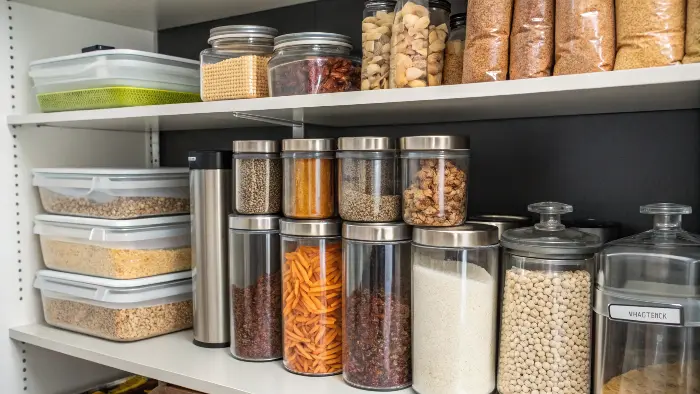Worried about plastics in your kitchen? Food storage can be a sneaky chemical minefield. Discover safe, healthy alternatives for your food and your family’s well-being.
For healthier living, seriously consider ditching most plastic food storage. Your best bets are materials like glass, stainless steel, or food-grade silicone. These champs reduce chemical leaching and microplastic exposure, keeping your food safer and fresher longer. Trust me on this one!
You’re probably thinking, "Ugh, overhauling my kitchen storage sounds like a massive headache!" I get it. It can feel like a huge task, especially when plastic is just everywhere. But honestly, making the switch is one of the best things I’ve done for my health and peace of mind. So, let’s dive into some common questions folks have when they start looking into this – I know I had a ton of them!
What is the healthiest container to store food in?
Choosing food containers can feel super overwhelming, can’t it? So many options, and many hide harmful chemicals. Let’s pinpoint the truly healthy choices for your kitchen and your peace of mind.
Generally, the healthiest food containers are made from glass, stainless steel, and high-quality, food-grade silicone. These materials are top-notch because they’re non-reactive, don’t leach nasty chemicals into your food, and are durable for long-term, everyday use.
When I first started my own plastic-free journey, figuring out the "healthiest" option felt like navigating a maze. But it boils down to a few key materials that consistently come out on top. We at Ecosourcecn always guide our partners, like Jacky, a sharp packaging specialist from Canada, towards these safer choices. It’s not just about being "green"; it’s about genuine health and product integrity.
Why Glass is a Great Choice
I absolutely love glass. It’s like the gold standard for food storage. Think about it – glass is inert, meaning it doesn’t react with food, so no weird chemicals are seeping into your leftovers. Plus, it doesn’t stain or hold onto odors. You know that lingering tomato sauce smell in old plastic containers? Gone with glass! I use glass jars with airtight lids for almost everything in my pantry – grains, nuts, seeds, you name it. My food stays fresher, and my pantry looks way more organized. It’s a bit heavier, sure, and you have to be careful not to drop it, but the benefits are huge. And it’s endlessly recyclable!
Stainless Steel: The Durable Option
If you’re worried about breakage, especially with kids around, stainless steel is your superhero. It’s lightweight, incredibly durable (practically indestructible!), and just like glass, it won’t leach chemicals or retain flavors. It’s perfect for lunchboxes, travel containers, and larger storage bins. The only tiny downside is you can’t see what’s inside easily, and most types aren’t microwave-safe. But for sturdiness and safety, it’s a winner. I’ve got a set of stainless steel tiffins I’ve been using for years – they still look brand new!
Food-Grade Silicone: Flexible and Safe?
Now, silicone is interesting. It’s a bit of a hybrid. Good quality, food-grade silicone is generally considered safe. It’s flexible, can handle heat and cold, and is a good alternative for things like reusable food bags (a fantastic swap for single-use plastic sandwich bags!) or baking mats. The key here is "food-grade" and avoiding cheap stuff that might have fillers. I always do the "pinch test" – if you pinch it and it turns white, it might have fillers. Pure silicone shouldn’t change color. It’s a great supporting player in a plastic-free kitchen. I use silicone lids for bowls and reusable bags for snacks – super handy.
Choosing the right material is a big step towards a healthier kitchen. It’s not just about avoiding plastic; it’s about actively choosing materials that support your well-being.
Does Tupperware leach microplastics?
That trusty old Tupperware, a staple in so many kitchens… but is it secretly harming your health? The concerns about microplastics are very real. So, let’s get straight to it and uncover the truth about those plastic containers.
Yes, unfortunately, plastic containers like Tupperware can leach microplastics and chemicals into your food. This risk gets higher when the plastic is heated (like in a microwave), scratched, or just plain old. Fatty or acidic foods can also make it worse.

I remember reading a study a while back, and it just hit me – all those plastic containers I’d diligently washed and reused, sometimes even microwaved for a quick reheat… 😱 It was a real eye-opener. It’s not to demonize every piece of plastic ever made, but when it comes to things that are in direct contact with our food, day in and day out, we need to be extra cautious.
How Do Microplastics Actually Get Into Our Food?
It’s pretty straightforward, sadly. Plastic isn’t as stable as we might think.
- Heat: Microwaving food in plastic containers is a big no-no. The heat can cause the plastic to break down faster, releasing tiny particles and chemicals. I used to do this all the time before I knew better!
- Wear and Tear: Every time you scrub a plastic container, or if it gets scratched from utensils, tiny bits of plastic can break off. These are the microplastics. Older containers that are cloudy or heavily scratched are prime suspects.
- Type of Food: Fatty foods (like oily sauces or cheese) and acidic foods (like tomatoes or citrus) can also encourage chemicals to leach out of the plastic.
It’s a bit unsettling to think about, isn’t it? Especially since these microplastics are so small we can’t even see them.The "BPA-Free" Myth – Is It Really Safer?
You’ve probably seen "BPA-Free" labels on plastic products and thought, "Oh good, this one’s safe!" I wish it were that simple. While Bisphenol-A (BPA) is a known endocrine disruptor, and it’s good that many companies removed it, the problem is what they often replace it with. Many "BPA-free" plastics use other bisphenols, like BPS or BPF, which studies are now showing can be just as harmful, if not more so. It feels a bit like a chemical whack-a-mole game. This is a big reason why, at Ecosourcecn, we advocate for materials that are inherently safe, rather than plastics that need constant scrutiny over their chemical makeup.
When to Definitely Ditch Your Plastic
So, when should you absolutely retire those plastic containers?
- If they’re scratched, cloudy, or warped.
- If you’ve used them for microwaving (even if they say "microwave-safe" – that often just means they won’t melt, not that they won’t leach).
- If they’re old. Plastic degrades over time.
Look, I get the convenience factor of plastic. It’s lightweight and often cheaper upfront. But for me, and for many of the businesses we work with who are making a conscious shift, the potential health risks just aren’t worth it for food storage.Is it better to store food in glass or plastic containers?
Glass or plastic for your food? This kitchen debate has been simmering for ages. But when it comes to your health and the environment, one option clearly comes out on top. Let’s settle this for your family’s well-being, shall we?
For both health and environmental reasons, glass is significantly better than plastic for food storage. Glass is inert, non-porous, doesn’t leach chemicals or microplastics, and is infinitely recyclable, unlike most plastics which have a much murkier end-of-life story.

I used to have a cupboard that was an absolute avalanche of mismatched plastic containers. You know the scene – lids that didn’t fit, containers stained orange from curry, and that faint, lingering smell of old spaghetti sauce. Ugh! Making the switch to predominantly glass storage was a game-changer. My food tastes cleaner, my fridge looks neater, and honestly, I just feel better knowing my kid’s lunch isn’t sitting in a plastic box all day, potentially absorbing who-knows-what.
A Clear Comparison: Glass vs. Plastic
| Let’s break it down. Sometimes seeing it side-by-side makes all the difference: | Feature | Glass | Plastic |
|---|---|---|---|
| Health Safety | Excellent (inert, no chemical leaching) | Poor to Fair (can leach chemicals & microplastics) | |
| Durability | Can break if dropped, but lasts very long | Scratches easily, warps with heat, degrades over time | |
| Heat Tolerance | Generally good (many are oven/microwave safe) | Poor (can melt/warp, leaches more when heated) | |
| Stain/Odor Free | Yes, doesn’t absorb stains or odors | No, prone to staining and retaining odors | |
| Taste Impact | None, preserves original food flavor | Can sometimes impart a "plastic" taste | |
| Environment | Made from natural materials, highly recyclable (can be recycled endlessly without quality loss) | Made from fossil fuels, low recycling rates, often downcycled, contributes to plastic pollution | |
| Visibility | Clear, easy to see contents | Can be clear, but often clouds over time | |
| Cost | Higher upfront cost, but cheaper long-term due to durability | Lower upfront cost, but needs frequent replacement |
Looking at this, the choice becomes pretty obvious, right? For almost every important factor, glass just performs better.
Beyond the Container: Thinking Long-Term
When we at Ecosourcecn talk to businesses about packaging, especially for food products, we always stress the importance of material integrity. Plastic might seem like a cheap and easy solution initially, but its downsides can impact brand perception and consumer trust in the long run. Glass, on the other hand, conveys quality and care. It’s an investment. Think about it – when you buy a premium food product, isn’t it often packaged in glass? There’s a reason for that.
I’ve also found that using glass encourages me to be more mindful about food storage. I can easily see what I have, which means less food waste. Those clear containers in the fridge remind me to eat my leftovers! And for items like grains, flours, and spices in the pantry, glass jars with airtight seals are just unbeatable for keeping things fresh. It’s a win-win-win: for health, for the environment, and even for reducing food waste. It just makes sense.
What is the best long term food storage method?
Are you tired of seeing good food go bad, and your money along with it? Proper long-term food storage is absolutely key. Let’s unlock some secrets to keep your food fresh, safe, and ready to eat for months, all while keeping it plastic-free.
The best long-term food storage methods generally involve using airtight, non-reactive containers like glass jars or stainless steel bins. These are often combined with techniques like vacuum sealing, freezing, or simply storing in consistently cool, dark, and dry places.

I’ve become a bit of a fanatic about long-term storage, mostly because I love buying in bulk – it saves money and a ton of packaging! My pantry is now a colorful array of glass jars filled with everything from lentils and rice to dried fruit and nuts. It’s actually quite satisfying to see it all so organized, and more importantly, to know it’s staying fresh without any plastic nasties leaching into it. Jacky, our Canadian packaging specialist friend we work with at Ecosourcecn, often asks about solutions for products that need a longer shelf life. We always emphasize that the material’s integrity over time is paramount. Plastic degrades; quality glass and stainless steel don’t.
Key Principles for Food Longevity
No matter what you’re storing, a few principles always apply for extending shelf life:
- Airtight is Essential: Oxygen is the enemy of freshness for many foods. Airtight seals prevent oxidation and keep moisture out (or in, depending on the food).
- Block Out Light: Light can degrade nutrients and spoil some foods. Dark storage or opaque containers (like stainless steel) are great for this.
- Cool and Consistent Temps: Fluctuating temperatures can cause condensation and spoilage. A cool, stable environment is best.
- Keep it Dry: Moisture encourages mold and bacterial growth.
Plastic-Free Pantry Staples: What to Use
For a truly effective and healthy long-term storage system, here’s what I rely on:
- Glass Jars with Airtight Lids: These are my number one go-to for dry goods. Think mason jars, Kilner jars, or any glass container with a good sealing mechanism. I use them for grains, beans, pasta, flour, sugar, coffee, tea, herbs, spices… everything! You can often buy attachments to vacuum seal mason jars too, which is amazing for super long-term storage.
- Stainless Steel Containers: For larger quantities or items you want to protect from light, food-grade stainless steel canisters with snug lids are excellent. I use these for things like big bags of flour or rice.
- Food-Grade Silicone Bags (for Freezing): While not for super long-term pantry storage, reusable silicone bags are fantastic for freezing fruits, veggies, soups, and prepped meals, replacing freezer-grade plastic bags. They handle the cold well and don’t leach.
- Root Cellar Principles (Even Without One): For things like potatoes, onions, and garlic, a cool, dark, and well-ventilated spot mimics a root cellar. I use woven baskets in the coolest part of my pantry.
Beyond the Container: Other Tips for Success
It’s not just about the container!
- Buy Fresh, Store Fresh: Store the best quality food you can. Don’t expect miracles from food that’s already on its way out.
- Label Everything: Date your stored items. First in, first out is a good rule.
- Consider Oxygen Absorbers: For super sensitive dry goods you want to keep for years (like in emergency preparedness), food-grade oxygen absorbers can be added to airtight containers.
- Proper Preparation: Some foods need to be blanched before freezing, or fully dried before pantry storage. Do a little research for specific items.
Building up a good long-term food storage system takes a bit of effort upfront, but the payoff in reduced waste, better nutrition, and peace of mind is totally worth it. Plus, a well-organized, plastic-free pantry is a thing of beauty! 🔥Conclusion
Making the switch to plastic-free food storage is a journey, not a race. Start small, prioritize your health, and enjoy the tasty benefits! Your body will thank you. 😉


